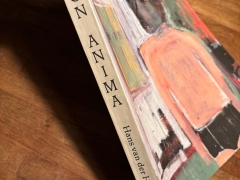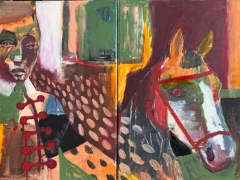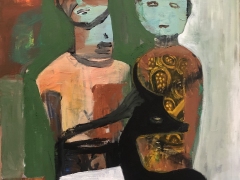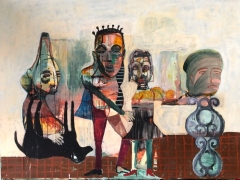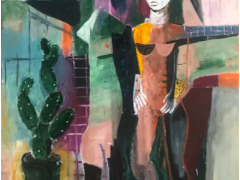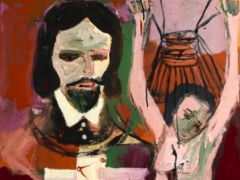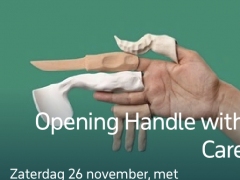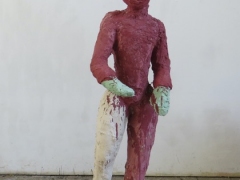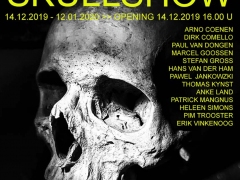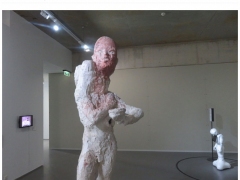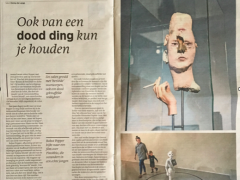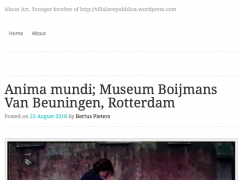THE RUMBLE IN THE JUNGLE - galleri KANT
The exhibtion 'The Rumble in the Jungle' presents the Dutch artist Hans van der Ham and the Belgian artist Anton Cotteleer for the first time in Denmark.
Hans van der Ham
Hans van der Ham (b.1960) is a Dutch painter and sculptor who lives and works in Rotterdam. He is educated at the Art Academy in Rotterdam (1989). Van der Ham has a background as a classical pianist from the conservatories in The Hague and Utrecht (1984). He has had many solo and group exhibitions in e.g. Holland, Belgium, and Germany, and he is represented in a large number of collections such as The Dutch Embassy in Buenos Aries, Museum Beelden aan Zee in The Hague, KPMG Art Collec5on Foundation and Princessehof Ceramics Museum in Leeuwarden.
Over the last 30 years, he has become known for his black sculptures in clay and his work with dark gouache and ink. Since 2020, he has further developed his oeuvre and today he also creates the oil painting based on this same dark and expressive style. Van der Ham's paintings are powerful and have a pervasive, almost painful darkness, where characters, animals, and figures are staged in dim spaces and landscapes. There are no concrete narratives in his paintings, they consist of fragments from anecdotes and hidden memories. He is inspired by tribal and Renaissance art which assumed that an image was animated. In the Renaissance, it was believed that the space of the painting was not a limited constructed space based on canvas and paint, but it was a space that the viewer could step into. This space van der Ham tabs into with his paintings as he almost tries to liberate the painting's captured souls as he expresses it. In van der Ham's paintings, his aesthetic approach draws a line to Cubism, German Expressionism, and Dutch Renaissance painting. A fundamental approach for van der Ham is spontaneity and turning thinking into action. By the physical act of painting, he tries to create an intuitive space where intellectual thinking becomes a bodily action. His background as a composer is also reflected in his practice, which he describes as follows: 'The beginning of a painting feels like the setting up of an orchestral score, after which the 'soloists' float to the surface of their own accord.'
Anton Cotteleer
Anton Cotteleer (b.1974) is a Belgian sculptor who lives and works in Kalmthout. He is educated at the art academy in Antwerp (1997) and HISK (2000) in Ghent. He has had several solo and group exhibitions in e.g. Belgium, Holland, Germany, and in England. He is represented at several collections and he has received many art awards,
including Award Club der XII, The Belgian Royal Academy of Arts in Antwerp, Laureate Grote prijs Ernest Albert van de stad Mechelen / Grote Prijs Ernest Albert, Mechelen in Belgium, The Hague Sculpture Partner Award and S<ch<ng Het Lange Voorhout in the Netherlands. He is currently completing his PhD at the Royal Academy of Arts in Antwerp.
The exhibition's sculptures are created from various forms of plas5c materials such as acrylic, resin, and epoxy, and the colourful sculptures all have a textle-like fluffy surface. Cotteleer's sculptures are elegant and move between the abstract and the figurative. He is particularly interested in how humans in a Western context seem to form personal and close bonds with domestcated animals. In his sculptures, Cotteleer cuts animals and people into fragments and reassembles them in a new way, which also seems to create a common skin. A female torso merges with a cat's tail and hind legs or a human head is given octopus arms which are placed on an everyday piece of furniture such as a stool. There is always latent autobiographical traces to be found in his sculptures such as memories, photographs, newspaper articles, and sensorial experiences. Despite the elegance of Cotteleer's sculptures, something sinister always seems to linger beneath the surface. The bodies are fragmented and reduced to mere body parts - a person is no longer present. Cotteleer is partially interested in the part of the body that has been removed and which is not present, he focuses on the individual body parts which for him have become figurations that he assembles with other body parts and objects that are covered in fluffy textile surfaces. The textile element he finds inspiration in Flemish home interior design such as carpets, curtains, and rugs that Cotteleer particularly remembers from his childhood. As he describes it in an interview: ‘My love for typical Flemish interiors probably stems from my childhood. When you are a kid, colours, smells, and shapes are more intense. Nowadays, I often work with materials and interiors that I had to avoid as a child because of asthma problems. I always try to work with contrasts. For example, I like to contrast my rather erotic configuration with “kneuterige”, or granny-like interior’. Cotteleer's practice draws lines to Surrealism, Dadaism, and the abstract sculptural tradition. With an elegant abstract lightness that is found in the German-French sculptor Jean Hans Arp (1886-1966) practice merges with the German photographer and sculptor Hans Bellmer's (1902-1975) deconstructed and someimes creepy composite mannequins dolls. Cotteleer's fragmented body parts, animal parts, and everyday objects which he emerges together in his sculptures create a common body, skin, and narrative.


